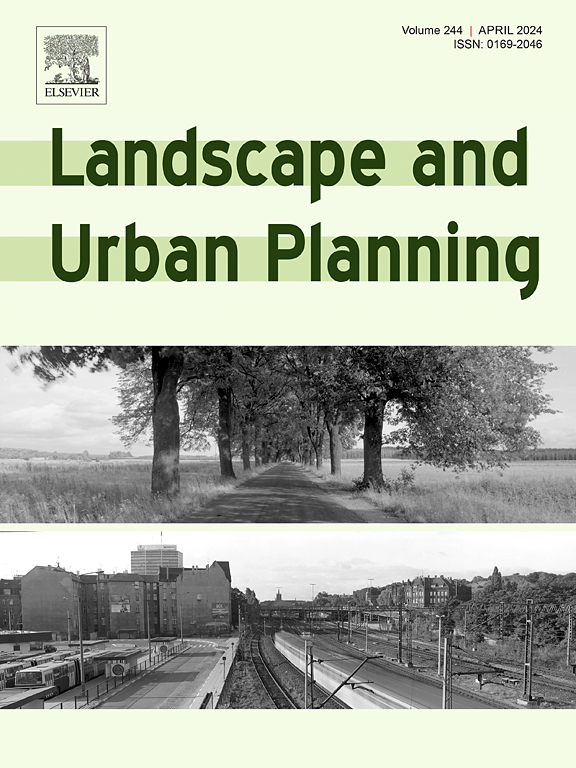Urban green space in transition: A cross-continental perspective from eight Global North and South cities
IF 7.9
1区 环境科学与生态学
Q1 ECOLOGY
引用次数: 0
Abstract
Urban green space (UGS) plays a vital role in enhancing the resilience and livability of cities. However, the distribution and accessibility of these spaces often vary significantly within and between cities, raising concerns about environmental justice and social equity. This study aims to analyze the spatiotemporal dynamics of UGS and assess population exposure and equality implications across eight diverse cities from the Global North (GN) and Global South (GS) over the past three decades. Employing a multimethod approach combining geospatial analysis, remote sensing, and statistical techniques, this study reveals an alarming global trend of decreasing UGS, with GS cities experiencing more rapid decline than GN cities. The analysis of UGS exposure uncovers distinct trends and variations across cities, with GN cities generally having higher exposure but showing a concerning decline over time, while GS cities display mixed patterns. Arid-climate cities Phoenix and Riyadh have managed to maintain low but stable UGS levels despite their unique climatic challenges. Urbanization emerges as a dominant force driving the decline in UGS, with GS cities facing significantly higher pressures than GN cities. The findings highlight the urgent need for comprehensive urban greening strategies that prioritize UGS protection and expansion, innovative policies, community engagement, and data-driven decision-making to promote equitable and sustainable urban environments. This study contributes to the growing research on urban greening by providing a comparative analysis of UGS trajectories and exposure equality implications across diverse cities, underscoring the importance of context-specific approaches and inclusive planning processes.
转型中的城市绿地:全球八个南北城市的跨洲视角
城市绿地(UGS)在提高城市的复原力和宜居性方面发挥着至关重要的作用。然而,这些空间的分布和可达性在城市内部和城市之间往往存在很大差异,从而引发了人们对环境正义和社会公平的关注。本研究旨在分析 UGS 的时空动态,评估过去三十年来全球北方(GN)和全球南方(GS)八个不同城市的人口接触情况及其对平等的影响。这项研究采用了地理空间分析、遥感和统计技术相结合的多种方法,揭示了令人担忧的全球铀矿覆盖率下降趋势,其中全球南方城市的铀矿覆盖率下降速度比全球北方城市更快。对UGS暴露程度的分析揭示了不同城市之间的明显趋势和差异,GN城市的暴露程度通常较高,但随着时间的推移出现了令人担忧的下降,而GS城市则表现出不同的模式。干旱气候城市凤凰城和利雅得尽管面临独特的气候挑战,但仍能保持较低但稳定的 UGS 水平。城市化是导致城市地下水位下降的主要原因,一般地质条件城市面临的压力明显高于一般地质条件城市。研究结果突出表明,迫切需要制定全面的城市绿化战略,优先考虑保护和扩大 UGS、创新政策、社区参与和数据驱动决策,以促进公平和可持续的城市环境。本研究通过对不同城市的 UGS 轨迹和暴露平等影响进行比较分析,强调了因地制宜的方法和包容性规划过程的重要性,为城市绿化研究的不断发展做出了贡献。
本文章由计算机程序翻译,如有差异,请以英文原文为准。
求助全文
约1分钟内获得全文
求助全文
来源期刊

Landscape and Urban Planning
环境科学-生态学
CiteScore
15.20
自引率
6.60%
发文量
232
审稿时长
6 months
期刊介绍:
Landscape and Urban Planning is an international journal that aims to enhance our understanding of landscapes and promote sustainable solutions for landscape change. The journal focuses on landscapes as complex social-ecological systems that encompass various spatial and temporal dimensions. These landscapes possess aesthetic, natural, and cultural qualities that are valued by individuals in different ways, leading to actions that alter the landscape. With increasing urbanization and the need for ecological and cultural sensitivity at various scales, a multidisciplinary approach is necessary to comprehend and align social and ecological values for landscape sustainability. The journal believes that combining landscape science with planning and design can yield positive outcomes for both people and nature.
 求助内容:
求助内容: 应助结果提醒方式:
应助结果提醒方式:


